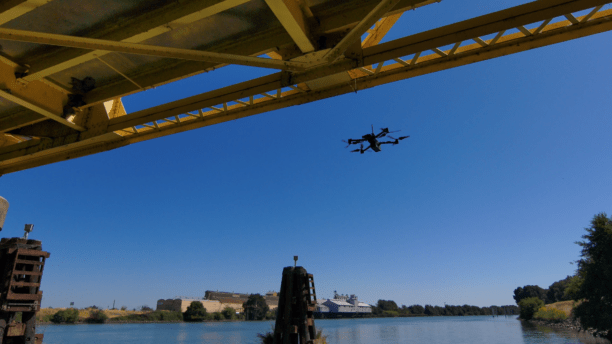
Moderated by Drone Industry Insights‘ Kay Wackwitz, the panel featured a variety of stakeholders: Brandon Groves from drone manufacturer Skydio, Barrit Lovelace from drone users and stakeholders Collins Engineers, and Travis Mason from automated pilot software provider Merlin Labs.
“We need to discuss not only the ‘wow’ factor of AI, but the ‘how’ factor,” said Wackwitz.
What is AI for Your Business?
“AI is a suite of technologies that allow computers and machines to perform tasks previously reserved for humans,” said Groves. “When it works, it really feels like magic. AI really is magical… but it’s also becoming real.”
In its first phase, Groves explained, AI is a tool for processing information: exemplified by tools like ChatGPT. “In phase 2, AI jumps off the page and into the real world, through robotics. AI moves beyond a tool, and becomes a teammate.” AI makes complex technology easy – and more available to more users, Groves said.
For Travis Mason, AI enables the collaboration between human and technology, leveraging the abilities of both. “The vastness of this technology and the vastness of it’s capability is really beautiful,” said Mason. “This is a big technology that will have a lot of impact. At Merlin Labs, we’re looking to build a pilot – just not a human one. We want to mimic the human capabilities and performance of a pilot – and it may sound crazy, but to date, aviation has done this very well.”
For Barrit, AI has made workflows easier. “We’re using AI for our every day work. For us, it’s right now.” Collins Engineers uses the Skydio autonomous platform, with Skydio’s 3D scan digital twin platform. “Flying a drone in traffic and around bridges used to be stressful,” said Barrit. “Now we’re bored. We’re just waiting for the drone to finish flying itself. ”
With AI-powered data analysis, the technology has replaced hours of tedious manual work. “AI is able to find features, things that we used to have to look for with our eyes. This is transformational… engineers don’t go to school for 4 years to stand out in a field and draw cracks. Engineers should be making decisions about what to do about the cracks,” said Barrit.
The Bottom Line: What’s the Value?
As every day users of drone technology, Barrit says that the value of AI is clear. “We can show cost savings, and sometimes those can be significant,” said Barrit. While those cost savings matter, AI enables a better quality of results in many ways. “When you create a digitial twin, it’s easier to share. For example, when we do quality control in engineering, we want two independent calculations. Performing two surveys is cost prohibitive. Now, we can create the digitial twin, and still have field survey…we have true quality control.”
Read more:
- Skydio AI-Empowered Drone Self Navigates in Flight Over Sydney Harbor, with First Deployment of Skydio Dock in Australia
- AI-Based Autonomy: Exyn Technologies Closes $35 Million in Series B Funding
- AI-Powered UAV Swarming Technology Steps Out of Science Fiction into Real World Scenarios
- Australian Surf Life Savers Trials AI-Powered, Long Range Search and Rescue Drones
Miriam McNabb is the Editor-in-Chief of DRONELIFE and CEO of JobForDrones, a professional drone services marketplace, and a fascinated observer of the emerging drone industry and the regulatory environment for drones. Miriam has penned over 3,000 articles focused on the commercial drone space and is an international speaker and recognized figure in the industry. Miriam has a degree from the University of Chicago and over 20 years of experience in high tech sales and marketing for new technologies.
For drone industry consulting or writing, Email Miriam.
TWITTER:@spaldingbarker
Subscribe to DroneLife here.
